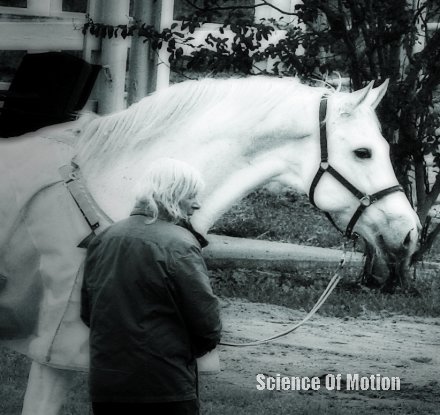Half Pass
Half pass on a circle or large pirouette from the perspective of
tensegrity and physical intelligence.


We are not talking about the half pirouette presented in the dressage ring, where the hind legs mark the steps but remain almost on the same spot. From the perspective of equine physical education, the move is without interest. We are talking about the large pirouette or half-pass on the circle that we practice at the Science of Motion.
Going right, half pass on a circle or large pirouette commences with the engagement and light adduction of the outside hind leg. The left hind leg creates the propulsive force that is going to be converted through the muscles of the thoracolumbar column into right lateral bending, coupled rotation, and displacement of the shoulders to the right. The right hind leg moves forward, but as the shoulders and the body move to the right, the inside hind leg advances under the body in a position of support. The position of the right hind leg advanced under the body is likely to increase the intensity and duration of the decelerating phase. This is how a large pirouette or half pass on a circle enhances balance control.
However, the horse has many ways to avoid the greater decelerating activity of the inside hind leg. Slight acceleration of the body or a shift of the weight over the forelegs could easily cancel the greater decelerating activity of the inside hind leg. Acceleration of shift of the body weight is more likely to be perceived by the rider’s body than the hands. The horse cans easily accelerate the motion or shift the weight on the forehand and neck without increasing the contact on the bit. This is why limiting lightness to the contact on the bit is a false understanding of lightness. The rider’s response has to be at the level of the body tone, influencing the horse’s back muscles instead of the hands. As soon as one feels the slight acceleration or shift of the horse’s body, one needs to adjust tensegrity or body tone to the horse reaction. Eventually, one might feel a slight increase in contact on the bit. The fingers should not cut the contact but instead filter it, informing the mind about adjusting the tone of the rider’s body. The key is harmonic tensegrity, a tone of the rider’s body matching the horse’s tensegrity, and allowing to feel nuances as soon as variation in the nuance starts. Going from relaxation to an adequate tone is too slow.
This is a fundamental evolution from the equitation of the correct aids. Gestures can be made without an appropriate tone. In his book, “Physical Intelligence,” Scott Grafton explains that the body is capable of reactions and almost “thoughts” more sophisticated than anything possible through manipulations and gestures. The body and the mind guide each other through life. To be effective, the equitation needs to rise at the level of subtle nuances in muscle tone. During the large pirouette, tensegrity allows the rider to feel and control light acceleration of the horse’s body before the horse body effectively accelerates. Tensegrity and subtle nuances in muscle tone, keep the conversation on the decelerating activity of the inside hind leg. At this level of conversation, the gymnastic is effective. If it takes one stride or two for the rider to feel the acceleration, it is too late, and the half pass on the circle does not increase the duration and intensity of the inside hind leg’s decelerating phase.
If one thinks, “I don’t feel it,” it is not because one lacks perception; it is because the conditions rendering the perception accurate, are not created. Improper tensegrity, too much or not enough, numbs the perception. The whole mental processing has to evolve. The body and the mind guide each other. The mind creates the conditions allowing the body to explore beyond average. If the horse does not feel the rider’s leg, the horse does not need more pressure of the rider’s leg. The horse needs a better analysis of the rider, figuring the dysfunction hampering the engagement of the horse’s hind leg.
The frequency is another element of success or lack of success. The rider needs to feel the acceleration before it starts as an increase or decrease of the tone has to be done at the horse frequency. An increase or decrease of the tone executed quicker than the horse’s frequency stimulates a protective reaction. Before the body accelerates, the horse increases the propulsive activity of the supporting hind leg. The horse also stiffens a little the thoracolumbar spine muscles. The rider cans feel the changes before the body accelerates or the weight shifts over the forelegs or on the neck. The rider can then progressively and adequately adjust the body tone.
Many have the skill of riding efficiently. The problem is not the lack of skill; the problem is the crudeness of traditional equitation. One learns formulas, the theoretical effect of the shoulder in or half pass, and believes that repeating the move educates the horse’s body. The horse is willing but protects his dysfunction instinctively. It belongs to the rider to understand the athletic demand of the movement and entertain a conversation guiding the horse mind toward efficient use of the horse’s physique.
“For things to reveal themselves to us, we need to be ready to abandon our views about them.” (Thich Nhat Hanh) For one, to ride at the level of one’s skill and the horse’s intelligence, it is necessary to converse with the horse within the space between stimulus and response.
Jean Luc
Learn about our online course IHTC


 twitter
twitter facebook
facebook google
google pinterest
pinterest linkedin
linkedin